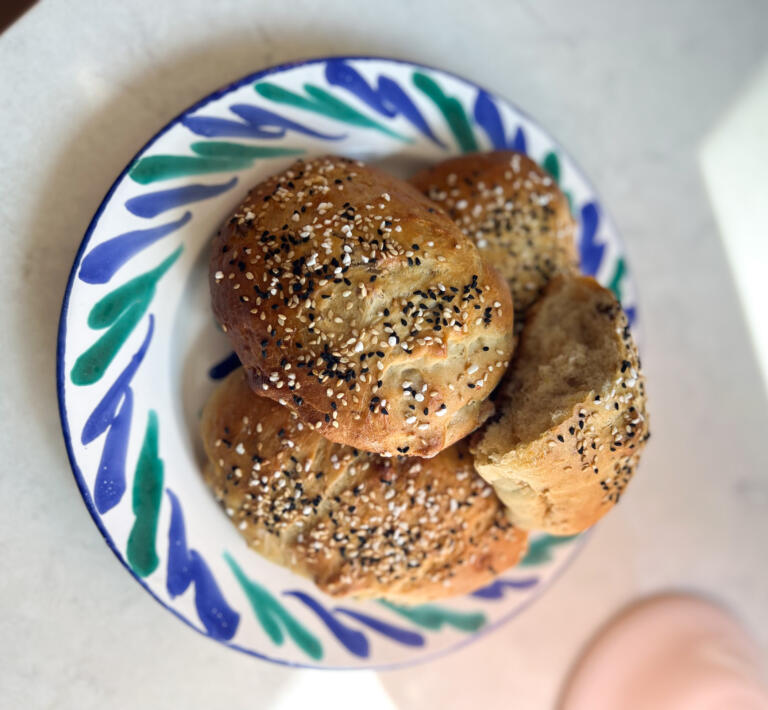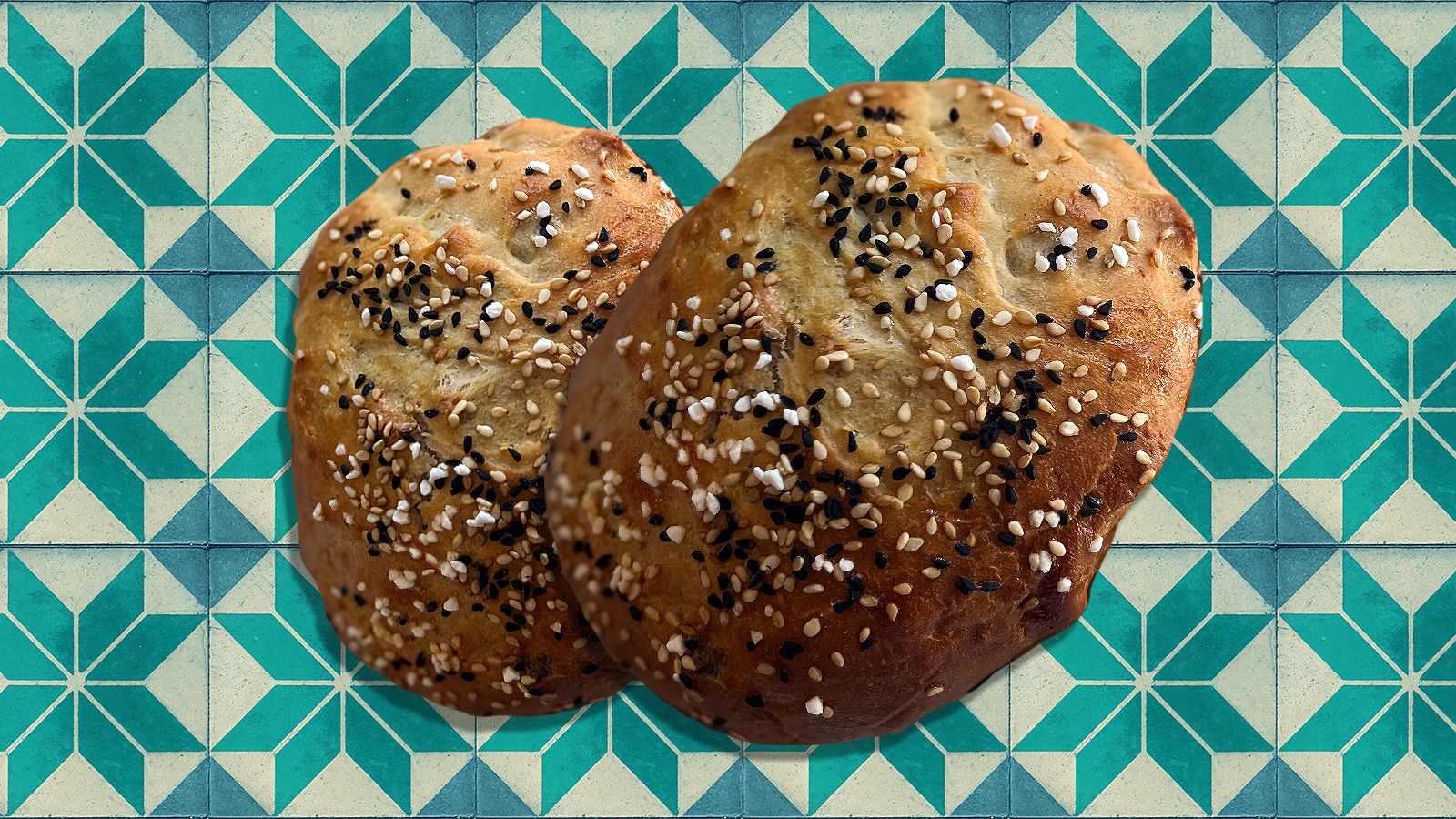What do you eat to break the Yom Kippur fast? Most Jewish grandmothers (and dietitians) agree that it’s best to break a fast slowly, with just a sweet drink and a pastry, and to wait a while before eating a full meal.
Ashkenazi Jews do this with a cup of tea and slice of lekach (honey cake); Persian Jews make a quick faloudeh out of grated apples, rose water and a bit of sugar, covered with ice. Iraqi Jews drink pepitada, a homemade almond- or melon-seed drink, alongside baba b’tamar, a date-filled cookie.
My friend Delphine Gamburg remembers how, as a young girl in Paris, her Algerian-born aunt would give her a boulou, a sweet roll filled with raisins and nuts, in a small bag to take to synagogue at the end of Yom Kippur. Delphine kept the boulou deep in the pocket of her coat, making sure it was safe. As the shofar was blown, marking the end of the fast, the little hungry girl would take the first bite right there in the synagogue, savoring the sweetness of this simple treat. She still remembers that sense of happiness and relief.
Tunisian, Libyan and Algerian Jews break their fast with bollo (or bolo or boulou, depending on their origin). This lightly sweetened small roll or cookie is dotted with raisins, fennel seed, sesame seeds, and sometimes nuts and nigella seeds. Libyan and Algerian Jews prepare theirs with yeast, making their bollo more like challah. They shape it into an oval roll or small oval loaf that’s then sliced and served. The Tunisian version is made with baking powder and is more like an oval cookie; some make it as a loaf and then slice it into cookies, similar to mandelbrot.
The Nosher celebrates the traditions and recipes that have brought Jews together for centuries. Donate today to keep The Nosher's stories and recipes accessible to all.
Bollo means “bun” in Spanish and Ladino, and indeed Sephardi communities around the world have dishes similar to this version from North Africa. In “The Classic Cuisine of the Italian Jews,” Edda Servi Michelin describes how Jews in her little town of Pitigliano would serve il bollo to break the fast, next to some sweet vermouth. Her version of il bollo uses yeast, so it’s similar to the Libyan version, and is spiced with fennel seeds. It was likely brought to Italy with immigrants from Spain after the Inquisition.
When Little Delphine arrived back home, the family had more of the boulou with a cup of coffee. Then they’d take a break and, later, they’d sit down for a meal of couscous with vegetables and chicken, just like other Jewish communities did at the same time around the world.
Notes:
- I highly recommend using SAF instant yeast; it’s available online and can keep for months in the freezer. When using instant yeast (see Direction 1), you should skip the process of proofing the yeast; if you’re using active dry yeast (see Direction 2), start the recipe by proofing the yeast and continue as usual.
- The rolls will keep at room temperature in a cloth or paper bag for up to three days. They can be frozen, thawed at room temperature and eaten once thawed or covered with aluminum foil and reheated in a 325°F oven for 10 minutes.
- You can swap out the nuts and dried fruit according to your taste.

Bollo Recipe
Bollo are small rolls stuffed with raisins and nuts, and seasoned with fennel and sesame seeds. Libyan bollo (of the Jews of Tripoli) is challah-like, and made with yeast, while Tunisian’s bollo is more like a biscotti, using baking powder instead of yeast. Both communities served bollo for break fast after Yom Kippur.
- Total Time: 3 hours
- Yield: 12 rolls
Ingredients
For the rolls:
- 1 lb all-purpose flour
- 4 tsp yeast (see note)
- ⅔ cup sugar
- 2 eggs, at room temperature
- ¾ cup warm water
- ¼ cup corn, avocado or mild olive oil
- 1 tsp vanilla extract
- ½ tsp salt
- ½ cup golden raisins, soaked in warm water and strained
- ½ cup chopped walnuts
- ¼ cup chopped or sliced almonds
- 1 Tbsp sesame seeds
- 1 ½ tsp fennel seeds
- zest of one orange
For the topping:
- 1 egg yolk
- 1 Tbsp water
- 2 Tbsp sesame seeds
- 1 Tbsp sanding sugar or regular sugar
Instructions
- If you’re using instant yeast, make the dough using a stand mixer with the dough hook. Put flour and yeast in the mixer’s bowl and mix with a fork. Add sugar, then turn mixer on medium-low speed and mix for 1 minute. Add eggs and water and continue to mix for about 2 minutes, until well incorporated. Stop the mixer as needed to scrape the flour from the sides using a spatula and continue to mix. With mixer on medium-low, add oil, then the rest of the ingredients (including raisins, nuts and spices). Knead for 8 minutes, stopping the mixer to scrape the sides as needed. The dough will be very soft, but don’t be tempted to add more flour. Skip to Direction 3.
- If you’re using active dry yeast, you need to proof it first: Put ¼ cup water, yeast and 1 tsp sugar in a glass and stir briefly. Let the mixture sit for 5-10 minutes until it visibly foams. Put flour in the bowl of a stand mixer fitted with the dough hook. Make a well in the center, and add yeast mixture, ½ cup water, the rest of the sugar and eggs to the well. Mix for about 3 minutes on medium-low speed, until well incorporated. Stop the mixer as needed to scrape the flour from the sides using a spatula and continue to mix. Add oil, then the rest of the ingredients (including raisins, nuts and spices). Turn speed to medium-low and mix for 8 minutes, stopping the mixer to scrape the sides as needed. The dough will be very soft, but don’t be tempted to add more flour.
- Remove bowl from stand mixer. Using a spatula, transfer dough into a lightly greased large bowl (I use PAM spray). Cover with plastic wrap and let stand at room temperature, preferably in a warm space (near the oven, for example), until dough doubles its volume, about 1-1½ hours.
- Deflate the dough, cover with plastic wrap and let it rise again for 1 hour, until it doubles in volume.
- Line a large baking sheet with parchment paper.
- Transfer dough onto a lightly floured work surface and roll into a thick log. Use a dough cutter to cut into 12 equal pieces. Roll each piece into a roll, then shape into an oval and put on the baking sheet. Keet 2 inches of space between each roll, as they rise in the oven.
- Cover the baking sheet with plastic wrap and let rolls rise for another 30 minutes. Meanwhile, preheat oven to 350°F.
- Mix egg yolk and water and gently brush rolls. Sprinkle with sesame seeds and sugar.
- Bake for 20-24 minutes, or until rolls are baked through and golden.
- Transfer to a cooling rack. Serve warm or at room temperature.
Notes
- I highly recommend using SAF instant yeast; it’s available online and can keep for months in the freezer. When using instant yeast (see Direction 1), you should skip the process of proofing the yeast; if you’re using active dry yeast (see Direction 2), start the recipe by proofing the yeast and continue as usual.
- The rolls will keep at room temperature in a cloth or paper bag for up to three days. They can be frozen, thawed at room temperature and eaten once thawed or covered with aluminum foil and reheated in a 325°F oven for 10 minutes.
- You can swap out the nuts and dried fruit according to your taste.
- Prep Time: 2 hours 40 minutes
- Cook Time: 20 minutes
- Category: Breakfast
- Method: Baking
- Cuisine: Holiday




What would the actual substitutions be for the Tunisian version with baking powder instead of yeast?
Hi Sid,
The Tunisian version requires a different recipe altogether, although the flavorings (raisins, nuts, orange, etc.) are the same. Rachel at The Nosher.
My mother made a bollo quite similar. She called them biscochos. I plan to make this without nuts,raisins, but I will use anise seeds to get the flavour of her rolls. Also I will use the yeast rather than baking powder.
Wonderful post! We are linking to this particularly great post on our website.
Keep up the great writing.